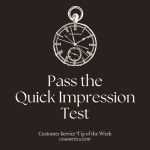
Mr. Robinson went to the hardware store with his teenaged son, Steve. Steve was starting his first woodworking project – building a small coffee table – and needed supplies. As they walked the aisles, Mr. Robinson and Steve couldn’t find the exact type of wood they wanted, so Mr. Robinson suggested that Steve ask an employee for help. Steve found an employee walking by, asked for help, and got what he needed.
After the employee walked away, Mr. Robinson told Steve: You did a good job talking with that gentleman. Next time, though, thank the employee.
Steve: Why should I thank the employee for doing his job?
The dad’s temperature started to rise. It rose because this was his son talking, and why Steve was basically stating a truth, Mr. Robinson felt Steve was missing the bigger picture.
Mr. Robinson: You thank them because they helped you, because we didn’t waste the next 30 minutes walking up and down every aisle, looking at every bin. You thank them because – whether they were being paid or not – you show appreciation for others.
This was a teachable moment in the dad’s eyes. You appreciate others. Gratitude is not a light switch you just turn on when you’re an employee getting paid to answer a customer’s question, and otherwise turn it off. Gratitude is an all-the-time thing, whether you’re an employee or a customer.
Mr. Robinson: People have choices – whether to serve you or not, whether to do it with a good attitude or not, whether to listen to you and ask questions…or not. You have a choice, too. And I want you to see the importance of choosing to tell other people thanks.
Let’s make gratitude an all-the-time thing.
Signup for FREE Tips! Contact Us More Resources for You Visit Our Home Page























